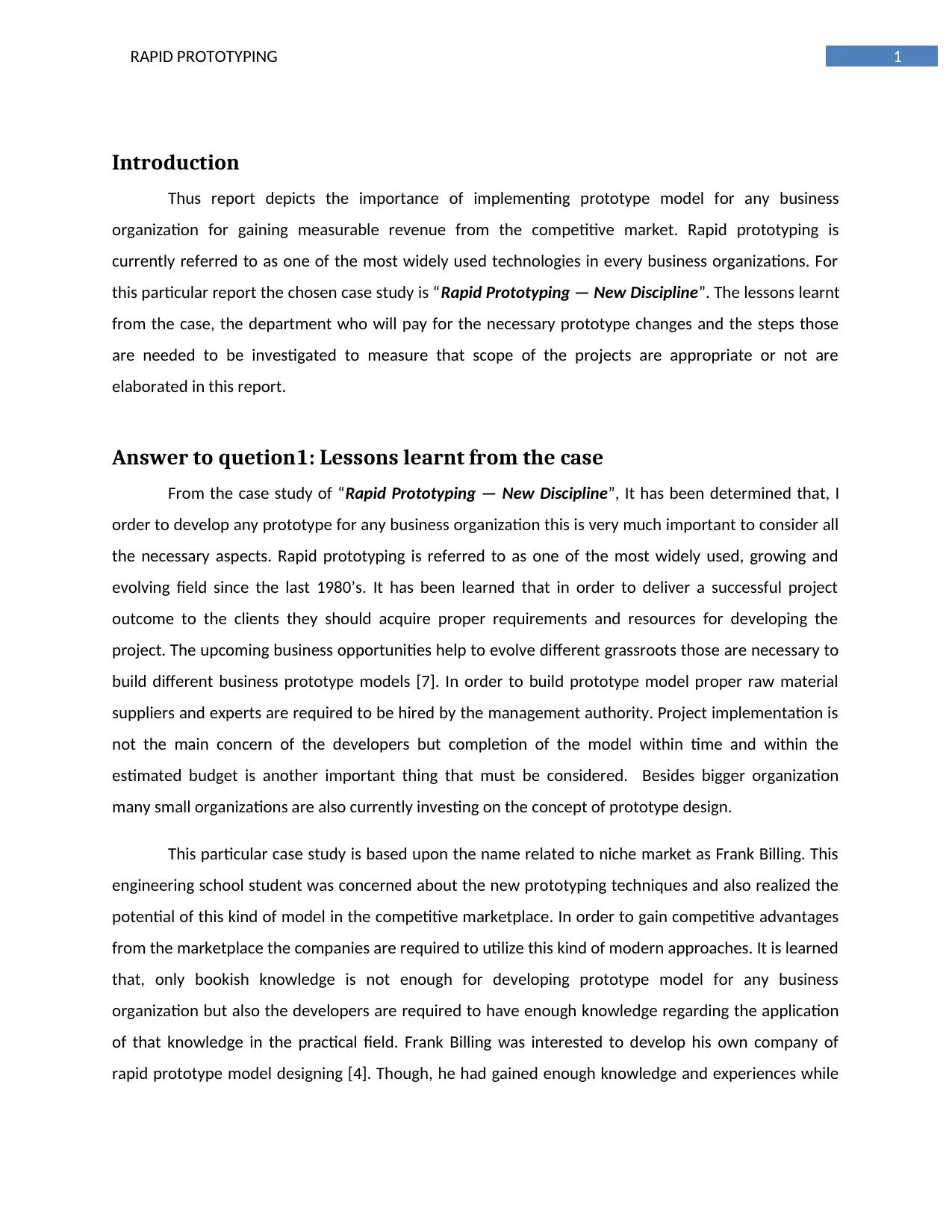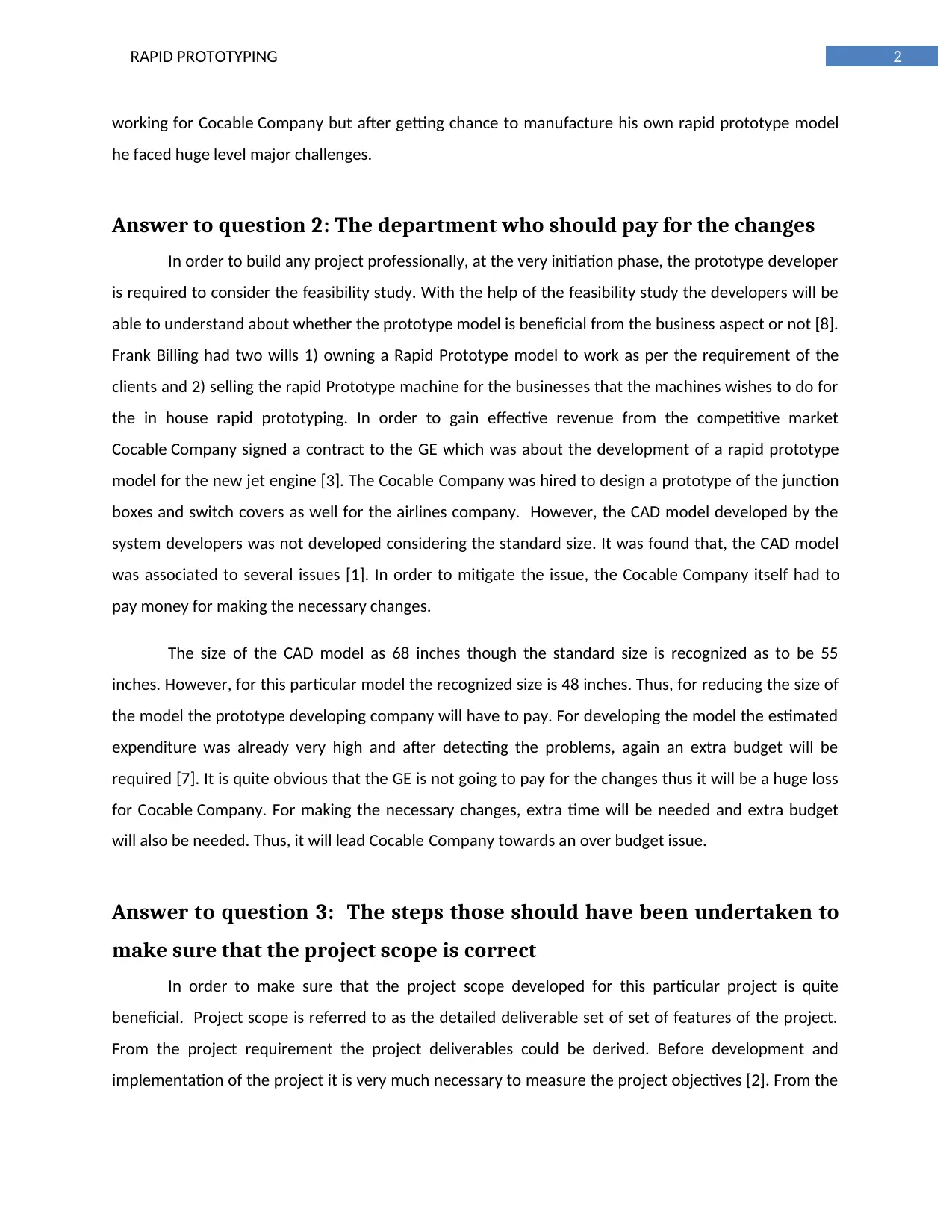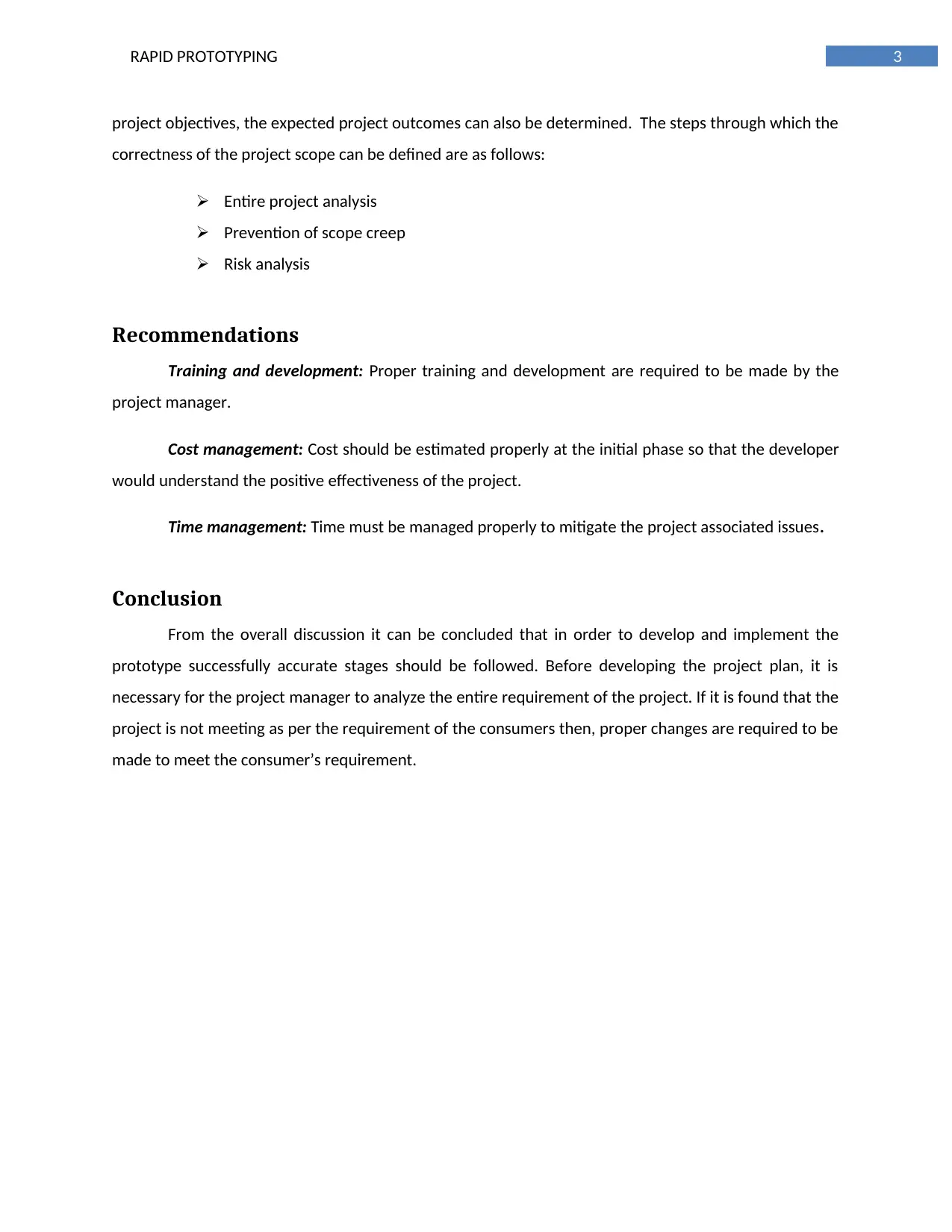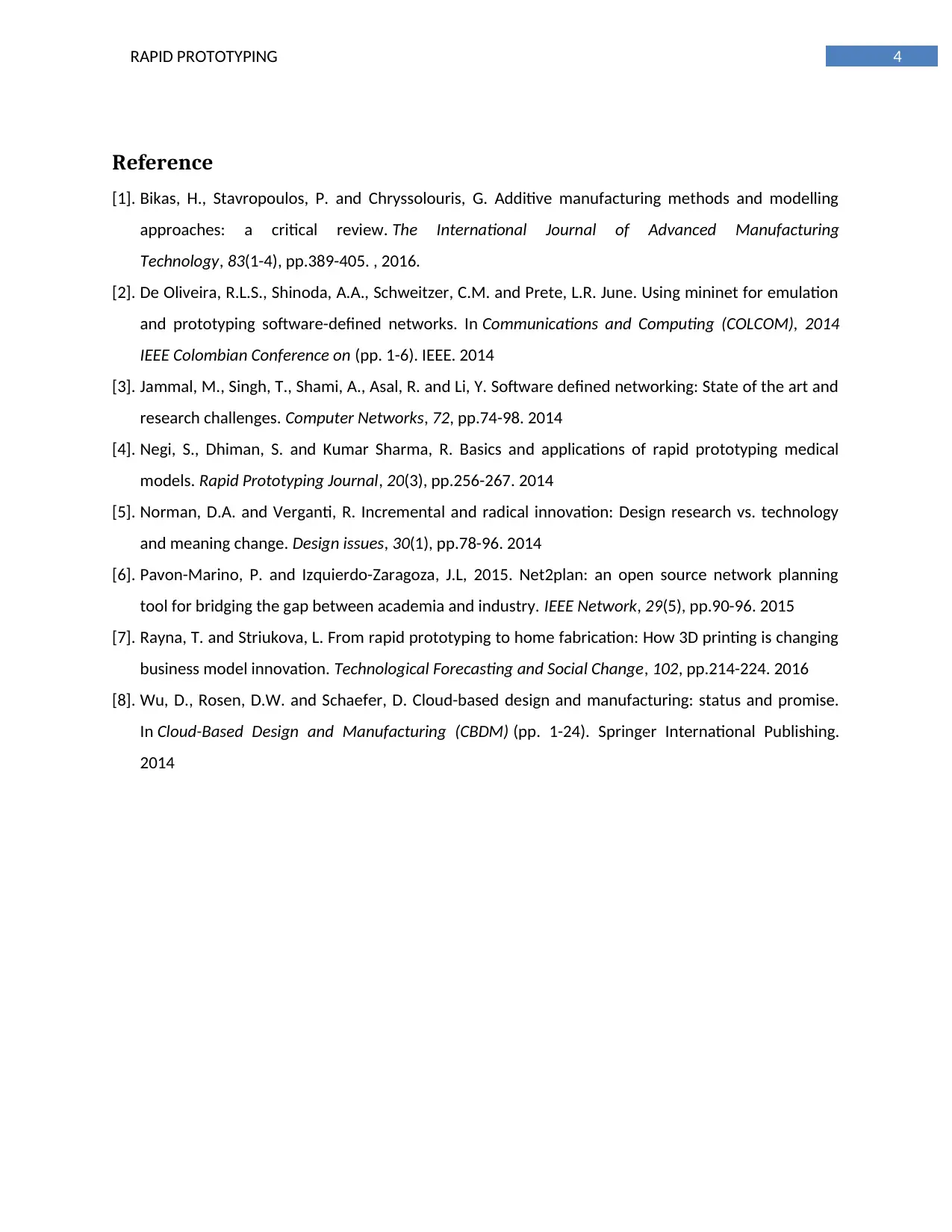University Business Report: Rapid Prototyping Case Study Analysis
VerifiedAdded on 2020/03/02
|5
|1424
|204
Report
AI Summary
This report presents a case study analysis focused on rapid prototyping, examining the challenges and opportunities within a business context. The case study, titled "Rapid Prototyping — New Discipline," explores the importance of prototyping in gaining a competitive advantage, emphasizing the need for thorough project planning, including feasibility studies, cost management, and time management. The report highlights lessons learned from the case, such as the significance of considering all aspects of project development, from raw material sourcing to the application of practical knowledge. It also addresses the financial responsibilities for prototype changes, specifically identifying which department should bear the costs. Furthermore, the report outlines the essential steps required to ensure the accuracy of project scope, covering areas like risk analysis, training, and project management strategies. The analysis concludes with a summary of recommendations for successful prototype development and implementation.

Running head: RAPID PROTOTYPING
Networking Case study: “Rapid Prototyping — New Discipline”
Name of the student:
Name of the university:
Networking Case study: “Rapid Prototyping — New Discipline”
Name of the student:
Name of the university:
Paraphrase This Document
Need a fresh take? Get an instant paraphrase of this document with our AI Paraphraser

1RAPID PROTOTYPING
Introduction
Thus report depicts the importance of implementing prototype model for any business
organization for gaining measurable revenue from the competitive market. Rapid prototyping is
currently referred to as one of the most widely used technologies in every business organizations. For
this particular report the chosen case study is “Rapid Prototyping — New Discipline”. The lessons learnt
from the case, the department who will pay for the necessary prototype changes and the steps those
are needed to be investigated to measure that scope of the projects are appropriate or not are
elaborated in this report.
Answer to quetion1: Lessons learnt from the case
From the case study of “Rapid Prototyping — New Discipline”, It has been determined that, I
order to develop any prototype for any business organization this is very much important to consider all
the necessary aspects. Rapid prototyping is referred to as one of the most widely used, growing and
evolving field since the last 1980’s. It has been learned that in order to deliver a successful project
outcome to the clients they should acquire proper requirements and resources for developing the
project. The upcoming business opportunities help to evolve different grassroots those are necessary to
build different business prototype models [7]. In order to build prototype model proper raw material
suppliers and experts are required to be hired by the management authority. Project implementation is
not the main concern of the developers but completion of the model within time and within the
estimated budget is another important thing that must be considered. Besides bigger organization
many small organizations are also currently investing on the concept of prototype design.
This particular case study is based upon the name related to niche market as Frank Billing. This
engineering school student was concerned about the new prototyping techniques and also realized the
potential of this kind of model in the competitive marketplace. In order to gain competitive advantages
from the marketplace the companies are required to utilize this kind of modern approaches. It is learned
that, only bookish knowledge is not enough for developing prototype model for any business
organization but also the developers are required to have enough knowledge regarding the application
of that knowledge in the practical field. Frank Billing was interested to develop his own company of
rapid prototype model designing [4]. Though, he had gained enough knowledge and experiences while
Introduction
Thus report depicts the importance of implementing prototype model for any business
organization for gaining measurable revenue from the competitive market. Rapid prototyping is
currently referred to as one of the most widely used technologies in every business organizations. For
this particular report the chosen case study is “Rapid Prototyping — New Discipline”. The lessons learnt
from the case, the department who will pay for the necessary prototype changes and the steps those
are needed to be investigated to measure that scope of the projects are appropriate or not are
elaborated in this report.
Answer to quetion1: Lessons learnt from the case
From the case study of “Rapid Prototyping — New Discipline”, It has been determined that, I
order to develop any prototype for any business organization this is very much important to consider all
the necessary aspects. Rapid prototyping is referred to as one of the most widely used, growing and
evolving field since the last 1980’s. It has been learned that in order to deliver a successful project
outcome to the clients they should acquire proper requirements and resources for developing the
project. The upcoming business opportunities help to evolve different grassroots those are necessary to
build different business prototype models [7]. In order to build prototype model proper raw material
suppliers and experts are required to be hired by the management authority. Project implementation is
not the main concern of the developers but completion of the model within time and within the
estimated budget is another important thing that must be considered. Besides bigger organization
many small organizations are also currently investing on the concept of prototype design.
This particular case study is based upon the name related to niche market as Frank Billing. This
engineering school student was concerned about the new prototyping techniques and also realized the
potential of this kind of model in the competitive marketplace. In order to gain competitive advantages
from the marketplace the companies are required to utilize this kind of modern approaches. It is learned
that, only bookish knowledge is not enough for developing prototype model for any business
organization but also the developers are required to have enough knowledge regarding the application
of that knowledge in the practical field. Frank Billing was interested to develop his own company of
rapid prototype model designing [4]. Though, he had gained enough knowledge and experiences while

2RAPID PROTOTYPING
working for Cocable Company but after getting chance to manufacture his own rapid prototype model
he faced huge level major challenges.
Answer to question 2: The department who should pay for the changes
In order to build any project professionally, at the very initiation phase, the prototype developer
is required to consider the feasibility study. With the help of the feasibility study the developers will be
able to understand about whether the prototype model is beneficial from the business aspect or not [8].
Frank Billing had two wills 1) owning a Rapid Prototype model to work as per the requirement of the
clients and 2) selling the rapid Prototype machine for the businesses that the machines wishes to do for
the in house rapid prototyping. In order to gain effective revenue from the competitive market
Cocable Company signed a contract to the GE which was about the development of a rapid prototype
model for the new jet engine [3]. The Cocable Company was hired to design a prototype of the junction
boxes and switch covers as well for the airlines company. However, the CAD model developed by the
system developers was not developed considering the standard size. It was found that, the CAD model
was associated to several issues [1]. In order to mitigate the issue, the Cocable Company itself had to
pay money for making the necessary changes.
The size of the CAD model as 68 inches though the standard size is recognized as to be 55
inches. However, for this particular model the recognized size is 48 inches. Thus, for reducing the size of
the model the prototype developing company will have to pay. For developing the model the estimated
expenditure was already very high and after detecting the problems, again an extra budget will be
required [7]. It is quite obvious that the GE is not going to pay for the changes thus it will be a huge loss
for Cocable Company. For making the necessary changes, extra time will be needed and extra budget
will also be needed. Thus, it will lead Cocable Company towards an over budget issue.
Answer to question 3: The steps those should have been undertaken to
make sure that the project scope is correct
In order to make sure that the project scope developed for this particular project is quite
beneficial. Project scope is referred to as the detailed deliverable set of set of features of the project.
From the project requirement the project deliverables could be derived. Before development and
implementation of the project it is very much necessary to measure the project objectives [2]. From the
working for Cocable Company but after getting chance to manufacture his own rapid prototype model
he faced huge level major challenges.
Answer to question 2: The department who should pay for the changes
In order to build any project professionally, at the very initiation phase, the prototype developer
is required to consider the feasibility study. With the help of the feasibility study the developers will be
able to understand about whether the prototype model is beneficial from the business aspect or not [8].
Frank Billing had two wills 1) owning a Rapid Prototype model to work as per the requirement of the
clients and 2) selling the rapid Prototype machine for the businesses that the machines wishes to do for
the in house rapid prototyping. In order to gain effective revenue from the competitive market
Cocable Company signed a contract to the GE which was about the development of a rapid prototype
model for the new jet engine [3]. The Cocable Company was hired to design a prototype of the junction
boxes and switch covers as well for the airlines company. However, the CAD model developed by the
system developers was not developed considering the standard size. It was found that, the CAD model
was associated to several issues [1]. In order to mitigate the issue, the Cocable Company itself had to
pay money for making the necessary changes.
The size of the CAD model as 68 inches though the standard size is recognized as to be 55
inches. However, for this particular model the recognized size is 48 inches. Thus, for reducing the size of
the model the prototype developing company will have to pay. For developing the model the estimated
expenditure was already very high and after detecting the problems, again an extra budget will be
required [7]. It is quite obvious that the GE is not going to pay for the changes thus it will be a huge loss
for Cocable Company. For making the necessary changes, extra time will be needed and extra budget
will also be needed. Thus, it will lead Cocable Company towards an over budget issue.
Answer to question 3: The steps those should have been undertaken to
make sure that the project scope is correct
In order to make sure that the project scope developed for this particular project is quite
beneficial. Project scope is referred to as the detailed deliverable set of set of features of the project.
From the project requirement the project deliverables could be derived. Before development and
implementation of the project it is very much necessary to measure the project objectives [2]. From the
⊘ This is a preview!⊘
Do you want full access?
Subscribe today to unlock all pages.

Trusted by 1+ million students worldwide

3RAPID PROTOTYPING
project objectives, the expected project outcomes can also be determined. The steps through which the
correctness of the project scope can be defined are as follows:
Entire project analysis
Prevention of scope creep
Risk analysis
Recommendations
Training and development: Proper training and development are required to be made by the
project manager.
Cost management: Cost should be estimated properly at the initial phase so that the developer
would understand the positive effectiveness of the project.
Time management: Time must be managed properly to mitigate the project associated issues.
Conclusion
From the overall discussion it can be concluded that in order to develop and implement the
prototype successfully accurate stages should be followed. Before developing the project plan, it is
necessary for the project manager to analyze the entire requirement of the project. If it is found that the
project is not meeting as per the requirement of the consumers then, proper changes are required to be
made to meet the consumer’s requirement.
project objectives, the expected project outcomes can also be determined. The steps through which the
correctness of the project scope can be defined are as follows:
Entire project analysis
Prevention of scope creep
Risk analysis
Recommendations
Training and development: Proper training and development are required to be made by the
project manager.
Cost management: Cost should be estimated properly at the initial phase so that the developer
would understand the positive effectiveness of the project.
Time management: Time must be managed properly to mitigate the project associated issues.
Conclusion
From the overall discussion it can be concluded that in order to develop and implement the
prototype successfully accurate stages should be followed. Before developing the project plan, it is
necessary for the project manager to analyze the entire requirement of the project. If it is found that the
project is not meeting as per the requirement of the consumers then, proper changes are required to be
made to meet the consumer’s requirement.
Paraphrase This Document
Need a fresh take? Get an instant paraphrase of this document with our AI Paraphraser

4RAPID PROTOTYPING
Reference
[1]. Bikas, H., Stavropoulos, P. and Chryssolouris, G. Additive manufacturing methods and modelling
approaches: a critical review. The International Journal of Advanced Manufacturing
Technology, 83(1-4), pp.389-405. , 2016.
[2]. De Oliveira, R.L.S., Shinoda, A.A., Schweitzer, C.M. and Prete, L.R. June. Using mininet for emulation
and prototyping software-defined networks. In Communications and Computing (COLCOM), 2014
IEEE Colombian Conference on (pp. 1-6). IEEE. 2014
[3]. Jammal, M., Singh, T., Shami, A., Asal, R. and Li, Y. Software defined networking: State of the art and
research challenges. Computer Networks, 72, pp.74-98. 2014
[4]. Negi, S., Dhiman, S. and Kumar Sharma, R. Basics and applications of rapid prototyping medical
models. Rapid Prototyping Journal, 20(3), pp.256-267. 2014
[5]. Norman, D.A. and Verganti, R. Incremental and radical innovation: Design research vs. technology
and meaning change. Design issues, 30(1), pp.78-96. 2014
[6]. Pavon-Marino, P. and Izquierdo-Zaragoza, J.L, 2015. Net2plan: an open source network planning
tool for bridging the gap between academia and industry. IEEE Network, 29(5), pp.90-96. 2015
[7]. Rayna, T. and Striukova, L. From rapid prototyping to home fabrication: How 3D printing is changing
business model innovation. Technological Forecasting and Social Change, 102, pp.214-224. 2016
[8]. Wu, D., Rosen, D.W. and Schaefer, D. Cloud-based design and manufacturing: status and promise.
In Cloud-Based Design and Manufacturing (CBDM) (pp. 1-24). Springer International Publishing.
2014
Reference
[1]. Bikas, H., Stavropoulos, P. and Chryssolouris, G. Additive manufacturing methods and modelling
approaches: a critical review. The International Journal of Advanced Manufacturing
Technology, 83(1-4), pp.389-405. , 2016.
[2]. De Oliveira, R.L.S., Shinoda, A.A., Schweitzer, C.M. and Prete, L.R. June. Using mininet for emulation
and prototyping software-defined networks. In Communications and Computing (COLCOM), 2014
IEEE Colombian Conference on (pp. 1-6). IEEE. 2014
[3]. Jammal, M., Singh, T., Shami, A., Asal, R. and Li, Y. Software defined networking: State of the art and
research challenges. Computer Networks, 72, pp.74-98. 2014
[4]. Negi, S., Dhiman, S. and Kumar Sharma, R. Basics and applications of rapid prototyping medical
models. Rapid Prototyping Journal, 20(3), pp.256-267. 2014
[5]. Norman, D.A. and Verganti, R. Incremental and radical innovation: Design research vs. technology
and meaning change. Design issues, 30(1), pp.78-96. 2014
[6]. Pavon-Marino, P. and Izquierdo-Zaragoza, J.L, 2015. Net2plan: an open source network planning
tool for bridging the gap between academia and industry. IEEE Network, 29(5), pp.90-96. 2015
[7]. Rayna, T. and Striukova, L. From rapid prototyping to home fabrication: How 3D printing is changing
business model innovation. Technological Forecasting and Social Change, 102, pp.214-224. 2016
[8]. Wu, D., Rosen, D.W. and Schaefer, D. Cloud-based design and manufacturing: status and promise.
In Cloud-Based Design and Manufacturing (CBDM) (pp. 1-24). Springer International Publishing.
2014
1 out of 5
Related Documents
Your All-in-One AI-Powered Toolkit for Academic Success.
+13062052269
info@desklib.com
Available 24*7 on WhatsApp / Email
![[object Object]](/_next/static/media/star-bottom.7253800d.svg)
Unlock your academic potential
Copyright © 2020–2025 A2Z Services. All Rights Reserved. Developed and managed by ZUCOL.





